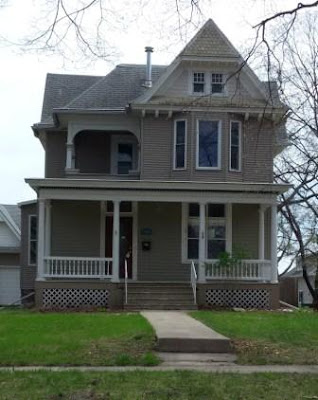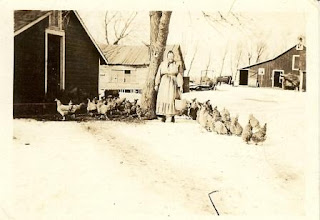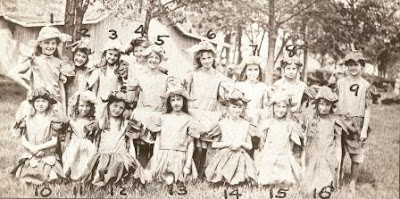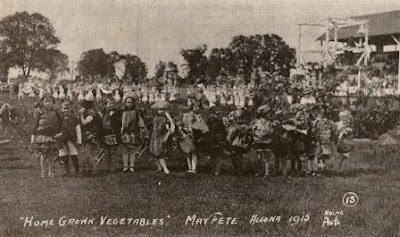With
Halloween just a couple of days away, I thought it might be interesting to
bring you a story of lies, deceit and, yes, cold blooded murder.
The Benjamins
Professor
L.T. Benjamin was hired by the Congregational Church of Algona in
1903 as
organist and musical director. He was a
master of the pipe organ and also taught organ and piano. Besides Professor Benjamin, the family
consisted of his wife, Minnie, and their three children, Mary, Paul and
Ralph. The family had previously resided
in Manson, Iowa, where the professor had held a similar position with the
Congregational Church there. They all
soon moved to Algona and settled into their new community.
 |
| L. T. Benjamin |
The
professor was very talented and almost immediately had large numbers of
students under his instruction. In
addition to providing all of the music for church services, Benjamin provided
music for weddings, funerals and other events at the church. He often provided music for various community
events and was a member of several community organizations including the Algona
Harp Orchestra for which he served as pianist.
Mrs.
Benjamin too became an active member of the community. She had a beautiful singing voice and often
joined her husband in providing music at the church. Minnie belonged to several organizations
including Eastern Star and the Women’s Library Aid Society. She became involved in the local Red Cross
serving in many capacities, finally as head of the entire Home Service
Department where she provided invaluable assistance to many soldiers and their
families during and after World War I.
Mrs. Benjamin became well known in the area for her kindness and
generosity.
So
it came as terrible shock to the entire community when on January 15, 1921, Minnie
was brutally murdered.
The Crime Scene
According
to an article published in the Upper Des
Moines Republican on January 21, 1921, the crime scene was described as
follows:
“The body of Mrs.
Benjamin lay upon the floor, the face covered with blood, the clothing
disarranged to give the appearance of another crime. The walls were spotted with blood in places
and the door and the casings were spattered.
Four holes were found on her head, inflicted with a hammer that was
found near by. One gash on top of the
head appeared to have been made with an axe.
The body was terribly bruised, the chest and the abdomen having apparently
been kicked. It was no doubt the most
brutal murder ever committed in northern Iowa.”
The
body was discovered by Professor Benjamin and their boarder, Alice Moline, when
they returned to the house in the evening.
Law enforcement along with Dr. Hartman were called. After examining the body, the doctor determined
that Mrs. Benjamin had been dead for about 30 minutes. A hammer which was determined to be the
murder weapon was found at the scene along with a rag soaked in blood which had
been thrown in the stove and was partially burned. Mrs. Benjamin was 53 years old.
The Investigation Begins
 |
| "The Death House on West State Street" as pictured in the January 26, 1921 edition of The Upper Des Moines - Republican |
Benjamin
denied the heinous crime. In his
statement to the police, he stated that he had been downtown conducting various
business transactions earlier in the afternoon.
He had encountered Mrs. Benjamin and the two of them had shopped at the
grocery store before returning home at 5:30 p.m. A neighbor saw him leave about 15 minutes
later and he went back downtown where he visited the County Savings Bank,
Miller Drug Store, and Moe & Sjogren’s where he purchased some fruit and a
loaf of bread. He visited Rexall Drug
Store where he bought a newspaper and then proceeded to Miner &
Stephenson’s Candy Kitchen where their boarder, Alice Moline, worked. Alice was engaged to be married to one of the
Benjamin sons. He waited for her to get
off work and the two of them walked home, finding the house dark and upon
entry, discovering the body.
Despite
his denials, County Attorney S. D. Quarton, Sheriff George Hackman, G. A.
Brunson, and state agent O. O. Rock continued their investigation and circumstantial
evidence began to mount. Two motives for
the crime were formulated. Their first
was that he wanted his wife out of the way.
Rumors had circulated through the area for several years that Benjamin
had been having an illicit affair with one of his students. Secondly, as the beneficiary of an insurance
policy on the life of his wife, he would receive proceeds of $1,000. Professor Benjamin had lost many of his
students due to the rumors of the inappropriate relationship and he had
recently resigned his position at the Congregational Church at the request for
the church trustees. He had obtained a
job in Chicago and he and his wife had been packing up their possessions for the
move when the slaying occurred. It was
well known that the couple were in financial straits.
Benjamin
was constantly grilled while in custody.
He refused to break.
The “Other Woman” Tells Her Story
Meanwhile,
the “other woman” was located and questioned.
Aged 31, she had met the professor three or four years earlier when she
began taking piano lessons from him. He
began to make advances toward her after just a few weeks of lessons. She found herself falling in love with him
and returned his advances. Knowing that
he was still married, she did move out of state for a short time, but soon
returned to him. Over and over again Benjamin told her that
he and his wife were planning to divorce and used multiple excuses as to why it was not happening.
When she would bring up the topic of the divorce, he kept blaming the delays
on inattentive attorneys or requirements set by the court regarding the minor
children. At one point he told her that
they had already received a divorce in Fort Dodge, but were living together
until their youngest son graduated from high school. Her parents investigated and found out that there was no divorce in Fort Dodge and confronted him. He eventually smoothed over the situation with "the other woman" and was able to convince her that he still planned to marry her. She states that shortly before the tragedy
occurred, Benjamin had told her that the divorce had been finalized and so
she had prepared her wedding clothes for the trip to Chicago.
At
some point, Minnie Benjamin discovered the affair and several times confronted
her husband, threatening divorce. Each
time he begged for her forgiveness and told her he would end the
relationship. The professor in fact did
not bring an end to the affair, but instead continued to conceal his true behavior to both women.
The Court Proceedings
On
the 25th of January, just ten days after the murder, a grand jury
was to be impaneled to determine whether or not charges would be brought
against him. That morning the professor
met with his attorney, T. P. Harrington.
Shortly before the arraignment set for 2 p.m., Benjamin met with his
children. That meeting appears to have
changed the defendant’s mind concerning his continued declarations of
innocence. Before the proceedings could
begin in earnest and at Benjamin’s request, Harrington requested to meet
privately with the presiding judge at which time the professor admitted his guilt. The County Attorney immediately filed murder
charges against him. The defendant was
then brought back into open court where he publicly admitted his guilt. Judge D. F. Coyle then stated that evidence
concerning the degree of murder would be taken the following Tuesday, February
1st.
Observers
began arriving early for the hearing.
When the Clerk arrived that morning, two men from LuVerne were found on
the floor immediately outside the courtroom sound asleep. When the hearing began, there was standing
room only and the hallways and stairs leading to the courtroom were too crowded
for law enforcement to pass without great difficulty. The defendant had to be brought into the
courtroom through the Clerk’s office.
The
defendant was sworn in and began giving his testimony. All questions were asked by the judge. He testified that problems arose in his
marriage beginning 12 to 15 years before.
The professor began drinking too much and flirting with other
women. He put no blame on his wife and
stated that the affair that he later entered into caused his family much shame
and distress. The public gossip caused
him to be ostracized which resulted in the loss of many students putting the
family into financial hardship. His
forced resignation from his position at the Congregational Church placed him
under extreme stress. There were many
bills and not enough money to make the move to Chicago.
He
stated that when he and his wife returned home from the grocery store the night
of the murder, he had gone out immediately to bring in some coal for the
stove. While he was gone, Mrs. Benjamin
got the mail and found a personal letter which she read. The professor stated that when he returned to
the house with the coal, he found her extremely wrought up. He did not know who the letter was from as
she threw it in the fire. He tried to
reason with her but she
became more agitated with him. Benjamin began to see all of the plans he had
made begin to unravel and, in a fit of frenzy, he picked up the hammer which
they had been using to seal the packing crates and struck a blow to her
head. He stated that he did not remember
anything that happened after the first blow and did not know why he attempted
to cover up the crime.
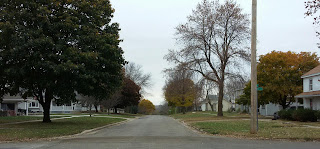 |
| Block of West State Street on which the Benjamin family lived as it looks in 2015 |
County
Attorney Quarton stated that the offense was clearly premeditated, setting out
all the evidence against the defendant, and adamantly argued for the death
penalty. Defense attorney Harrington argued
that the deed was not premeditated but that the defendant had acted on
impulse. He stated, “It seems to me that
no sane man could contemplate such an act as was committed. Mr. Benjamin was considered an average man
intelligently.”
Sentence is Pronounced
 |
| Judge D. F. Coyle |
Professor
L. T. Benjamin died at the prison following a hernia operation in April of 1923
after serving just two years and two and a half months of his sentence. Where he was buried is not known.
Until
next time (and Happy Halloween!),
Jean
(a/k/a Kossuth County History Buff)
If you enjoyed this
post, please don’t forget to “like” and SHARE to Facebook. Not a Facebook
user? Sign up with your email address in the box on the right to have
each post sent directly to you.
Be sure to visit the
KCHB Facebook page for more interesting info about the history of Kossuth
County, Iowa.
Reminder: The posts on Kossuth County History Buff are ©2015 by Jean
Kramer. Please use the FB “share” feature instead of cutting/pasting.








